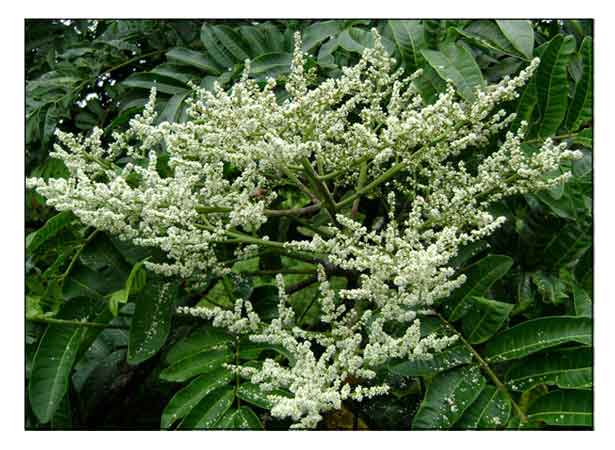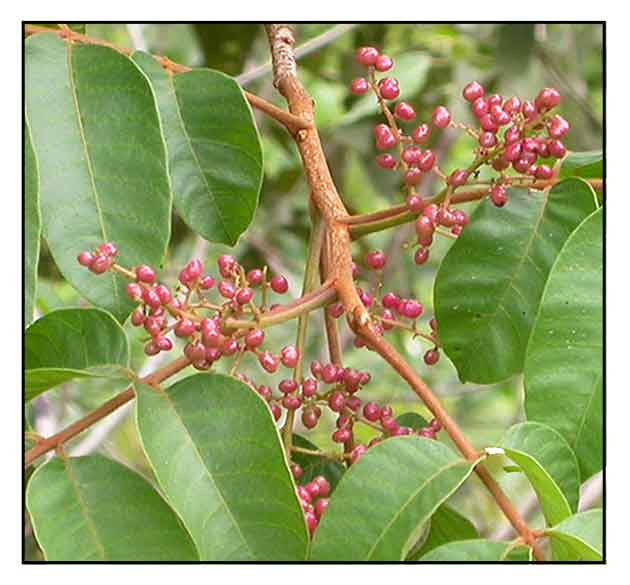 Gen info Gen info
- Rhus taitensis is a small tree of shrub in the sumac family of plants.
- There has been conflict on the treatment of the genus Rhus, some as a genus comprising of just 35 species, while others view it as a looser genus comprising about 250 species with several subgenera. (3)
- The genus Rhus contains species with highly toxic or irritant sap, which as included in Toxicodendron. The poisonous species (Toxicodendron) have axillary panicles and smooth fruits, while the non-poisonous species (Rhus) have compound terminal panicles and fruits covered with acid crimson hairs. However, in susceptible people, there ie concern the sap of some species can cause a skin rash. (3)
- Rhus spp. are commonly referred to as 'sumac.' Rhus taitensis' has taken 'sumac' as a common name.
Botany
Rhus taitensis is a tree growing up to 30 m. Bole is cylindrical, sometimes with buttresses, up to 70 cm diameter. Exudate emerging from layers in the blaze. Lenticels often large and conspicuous, more than 1 cm diameter. Leaflet blades about 4-15 x 1.5-5 cm. Leaflets and twigs produce a milky exudate. Pulvinus usually apparent on the terminal leaflet. Inflorescence quite large and complex. Calyx lobes broadly ovate, about 0.8-1 mm long. Petals narrowly ovate, elliptic or obovate, glabrous outside, pilose inside for the lower half, about 2-2.5 mm long. Disk 10-lobed. Stamens inserted outside the disk, filaments about 1-1.2 mm long , anthers about 0.8-1 mm long. Fruits produced in great abundance. Fruits ovoid, but laterally compressed, about 6-8 x 4-8 mm. Seeds enclosed in a hard endocarp. Seeds flattened, about 2-3 mm diam. Cotyledones 3-veined. (2)
 Rhus taiteneis is a large tree up to 30 m or more in height, with puberulent young stems and with the trunk base typically extending into low buttresses; bark mottled brown, rough, inner bark red-brown to pink oozing white sap, wood cream-colored. Leaves odd- (sometimes even-) pinnately compound, alternate, rachis mostly 15-50 cm long, pubescent, leaflets 7-19, opposite or sometimes alternate, blades mostly elliptic, 4-20 cm long, reddish when young, oblique at the base, rounded or broadly acute to acuminate at the tip; surfaces pubescent to subglabrous,l upper side darker with red to yellow veins, veins of lower side often pubescent; margins entire; petiolule 1-5 mm long. Inflorescence a terminal or upper-axillary, widely branching, many-flowered panicle 8-30 cm long, with a densely pubescent axis; flowers unisexual, trees dioecious. Calyx deeply divided into 5 subround lobes 0.5-1 mm long, subsessile. Corolla rotate, with 5 white to pink, orbicular petals 1.5-2 mm long. Ovary of female flower superior; styles 3, each with a short terminal stigma; ovary vestigial in the male flower. Stamens of male flowers 5, free, absent in the female flowers. Fruit a shiny black, compressed-ellipsoid drupe 3-5 mm in diameter. Flowering typically from March to September (but sometimes beyond this, e.g., December), fruiting during most months (and perhaps persisting on the inflorescence), but not at the same time as flowering, with a peak from April to October (Trail n.d.). Distinguished by its large tree habit; milky sap; alternate, odd-pinnately compound leaves that are reddish when young; large dense panicles of tiny white to pink, 5-parted flowers; and small, shiny black drupes. (Rainforest Trees of Samoa) (8) Rhus taiteneis is a large tree up to 30 m or more in height, with puberulent young stems and with the trunk base typically extending into low buttresses; bark mottled brown, rough, inner bark red-brown to pink oozing white sap, wood cream-colored. Leaves odd- (sometimes even-) pinnately compound, alternate, rachis mostly 15-50 cm long, pubescent, leaflets 7-19, opposite or sometimes alternate, blades mostly elliptic, 4-20 cm long, reddish when young, oblique at the base, rounded or broadly acute to acuminate at the tip; surfaces pubescent to subglabrous,l upper side darker with red to yellow veins, veins of lower side often pubescent; margins entire; petiolule 1-5 mm long. Inflorescence a terminal or upper-axillary, widely branching, many-flowered panicle 8-30 cm long, with a densely pubescent axis; flowers unisexual, trees dioecious. Calyx deeply divided into 5 subround lobes 0.5-1 mm long, subsessile. Corolla rotate, with 5 white to pink, orbicular petals 1.5-2 mm long. Ovary of female flower superior; styles 3, each with a short terminal stigma; ovary vestigial in the male flower. Stamens of male flowers 5, free, absent in the female flowers. Fruit a shiny black, compressed-ellipsoid drupe 3-5 mm in diameter. Flowering typically from March to September (but sometimes beyond this, e.g., December), fruiting during most months (and perhaps persisting on the inflorescence), but not at the same time as flowering, with a peak from April to October (Trail n.d.). Distinguished by its large tree habit; milky sap; alternate, odd-pinnately compound leaves that are reddish when young; large dense panicles of tiny white to pink, 5-parted flowers; and small, shiny black drupes. (Rainforest Trees of Samoa) (8)
Distribution
- Native to the Philippines.
- Grows primarily in the wet tropical biome.
- Also native to Bismark Archipelago, Caroline Is., Cook Is., Fiji, Jawa, Lesser Sunda Is., Maluku, Marianas, New Guinea, Niue, Queensland, Samoa, Society Is., Solomon Is., Sulawesi, Tonga, Vanuatu, Wallis-Futuna Is. (1)
- In primary dryland rain-forest, in inundated forest along rivers, in clearings, secondary forests or savannahs, at sea level up to 1,950 meters.
 Constituents Constituents
- Study of petrol extract of leaves isolated a new lupane type triterpene, 3ß,20,25-trihydroxy lupane, together with known compounds, 3,20-dihydroxylupane (1), 20-hydroxylupane-3-one (2), 20,28-dihydroxylumpane-3-one (3), 3,16-dihydroxy lupa-20(29)-ene (4) and 28-hydroxy-ß-amyrone. (5)
- Bioassay-guided fractionation of methanolic extract of Rhus taitensis leaves and twigs isolated a new triterpene, tetrahydroxysqualene (1).(see study below) (5)
Study of leaves and twigs isolated two new triterpenoids, namely: 1,10,24,25,30-pentahydroxysqualene (1), and dammar-2-(22),24-diene-3ß,26,27-triol (2). (see study below) (6)
Properties
- Studies have suggest antimycobacterial tuberculosis properties.
Parts used
Leaves, twigs.
Uses
Folkloric
- No reported folkloric medicinal use in the Philippines.
- In Tahiti, used for treatment of diarrhea; in the Solomon Is., used for deafness. (75)
Studies
• Tetrahydroxysqualene / Antimycobacterial / Leaves and Twigs: Bioassay-guided fractionation of methanolic extract of Rhus taitensis leaves and twigs isolated a new triterpene, tetrahydroxysqualene (1). The compound exhibited antituberculosis activity with MIC of 10.0 µg/mL, while showing only modest cytotoxicity. (5)
• New Antimycobacterial Triterpenoid / Leaves and Twigs: Study of leaves and twigs isolated two new triterpenoids, namely: 1,10,24,25,30-pentahydroxysqualene (1), and dammar-2-(22),24-diene-3ß,26,27-triol (2). Both compounds exhibited moderate antimycobacterial activities with MIC of 45 µg/mL. (6)
Availability
Wild-crafted.
|

![]()






